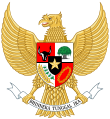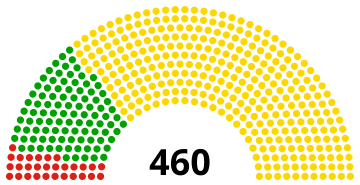1977 Indonesian legislative election
| |||||||||||||||||||||||||||||||||||||||||
360 of the 460 seats in the House of Representatives 181 seats needed for a majority | |||||||||||||||||||||||||||||||||||||||||
|---|---|---|---|---|---|---|---|---|---|---|---|---|---|---|---|---|---|---|---|---|---|---|---|---|---|---|---|---|---|---|---|---|---|---|---|---|---|---|---|---|---|
| |||||||||||||||||||||||||||||||||||||||||
 Results of the election by regency Golkar PPP | |||||||||||||||||||||||||||||||||||||||||
| |||||||||||||||||||||||||||||||||||||||||
| This article is part of a series on the |
| Politics of Indonesia |
|---|
 |
Legislative elections were held in Indonesia on 2 May 1977. They were the third legislative elections since independence, and the second under the New Order regime. There were three participants; the two political parties and functional group Golkar.
Background
[edit]In 1971, the New Order regime of Indonesia held the first legislative elections since 1955 in an effort to establish a system of government with President Suharto and the Indonesian military in control and to give this system legitimacy. Thanks to government manipulation of the nine contesting parties and intervention by the government and the military, the government-sponsored Golkar organization won 63 percent of the vote, giving it 227 of the 251 directly elected seats in the DPR as well as all nine indirectly elected seats in Western New Guinea. Golkar was also awarded the remaining 100 seats according to the provisions of the 1969 Election Law, giving it 336, almost three quarters of the total.[1][2][3]
President Suharto had long wanted the political parties to be "simplified", and in 1972, he said that this simplification would be complete if there were only three ballot symbols in the next election, a sentiment echoed by Suharto's personal assistant and head of the Special Operations (Opsus) unit Ali Murtopo, who said the 1976 election (as it was then scheduled) would only be contested by three "flags", namely those of the two parties and one functional group. In January 1973, this was realized in the forced fusion of the nine existing political parties into two: the four Islamic parties were combined into the United Development Party (PPP) and the nationalist and Christian parties formed the Indonesian Democratic Party (PDI).[4][5]
In its 1973 session, the People's Consultative Assembly reelected Suharto president for a five-year term and passed a resolution stating that the election would be held at the latest by the end of 1977 and that there would be three participants, the two political parties and the 'functional group' Golkar. The election was finally scheduled for 1977, the extra year being necessary for the New Order to have enough time to make the necessary changes to laws to ensure its victory.[5][6][7]
The government began preparing for the election in 1975 when it sent the necessary legislation for approval to the DPR. There were two bills, one on the party system and one on the organization of the election. They were designed to make it easier for Golkar to defeat the two parties by banning civil servants from joining political parties (i.e. not including Golkar), obliging parties to adopt the state philosophy Pancasila and the 1945 Constitution as their sole ideology and not allowing parties to organize below the level of the district. There was strong opposition to these proposals from both the parties, and this resulted in a compromise on all three, in particular with the PPP being allowed to be based on Islam.[8]
As in 1971, the government screened all election candidates and disqualified 19% from the PPP, 16% from the PDI and 5% from Golkar.[9]
Campaign
[edit]The campaign lasted from 24 February to 24 April. The week before the 2 May vote was a "quiet week".[10] During the campaign, there were a total of 203 recorded violations, 103 by the United Development Party, 38 by the Indonesian Democratic Party, 22 by Golkar, 15 by officers and 25 anonymously.[11]
Results
[edit]The 100 unelected seats were filled by appointed Golkar representatives, including 75 from ABRI and four from the new province of East Timor, which was "not yet able to hold elections".[12]
 | ||||||||
|---|---|---|---|---|---|---|---|---|
| Party | Votes | % | Seats | |||||
| Elected | Appointed | Total | ||||||
| Golkar | 39,750,096 | 62.11 | 232 | 100 | 332 | |||
| United Development Party | 18,743,491 | 29.29 | 99 | 0 | 99 | |||
| Indonesian Democratic Party | 5,504,757 | 8.60 | 29 | 0 | 29 | |||
| Total | 63,998,344 | 100.00 | 360 | 100 | 460 | |||
| Registered voters/turnout | 70,378,750 | – | ||||||
| Source: KPU, Sudibjo[13] | ||||||||
Aftermath
[edit]The newly elected members of the DPR were sworn in on 1 October 1977.[12] In March 1978 Suharto was re-elected as president for a third term.
References
[edit]- Notes
- ^ Liddle 1978a, p. 178.
- ^ Schwarz 1999, p. 70.
- ^ Nishihara 1972, pp. 1–2.
- ^ Subekti 2014, p. 79-81.
- ^ a b Liddle 1978b, p. 126.
- ^ Sekretariat Jenderal DPR-RI 1983, p. 1.
- ^ Nainggolan 2001, p. 309.
- ^ Liddle 1978b, pp. 126–127.
- ^ Liddle 1978b, p. 127.
- ^ Liddle 1978a, p. 179.
- ^ "Presiden berikan peringatan2 ttg penyelesaian akhir Pemilu". Pelita. Jakarta. 3 May 1977.
- ^ a b Sekretariat Jenderal DPR-RI 1983, p. 7.
- ^ Sudibjo, p156
- Sources
- Liddle, R. William (1978a), "Indonesia 1977: The New Order's Second Parliamentary Election", Asian Survey, 18 (2), University of California Press: 175–185, doi:10.2307/2643311, JSTOR 2643311
- Liddle, R. William (1978b), "The 1977 Election and New Order Legitimacy", Southeast Asian Affairs, ISEAS - Yusof Ishak Institute: 122–138, doi:10.1355/SEAA78K
- Nainggolan, Poltak Partogi (2001). "Parlemen dalam Konteks Sejarah 1959-1998" [Parliaments in the Context of History 1959-1998]. In Yayasan API (ed.). Panduan Parlemen Indonesia [Directory of the Indonesian Parliament] (in Indonesian). Yayasan API. pp. 299–324. ISBN 979-96532-1-5.
- Nishihara, Masashi (1972), Golkar and the Indonesian elections of 1971, Modern Indonesia Project, Cornell University, ISBN 978-0877630043
- Ricklefs, M.C. (2008) [1981], A History of Modern Indonesia Since c. 1200 (4th ed.), Palgrave MacMillan, ISBN 978-0-230-54686-8
- Sekretariat Jenderal DPR-RI (1983). Dewan Perwkilan Rakyat Republik Indonesia Periode 1977-1982 [Republic of Indonesia People's Representative Council 1977-1982] (PDF) (in Indonesian).
- Schwarz, Adam (1999), A Nation in Waiting: Indonesia in the 1990s (2nd ed.), Allen & Unwin, ISBN 9781760636913
- Sudibjo, M., ed. (1995). Pemilihan Umum 1992: Suatu Evaluasi [The 1992 General Election: An Evaluation] (in Indonesian). Jakarta: Center for Strategic and International Studies. OCLC 32449151.
- Subekti, Valina Singka (2014). Partai Syarikat Islam Indonesia: Konstelasi Politik hingga Konflik Kekuasaan Elite [Indonesian Islamic Union Party: Political Constellation to Conflict among the Political Elite] (in Indonesian). Center for Strategic and International Studies. ISBN 978-979-461-859-2.



